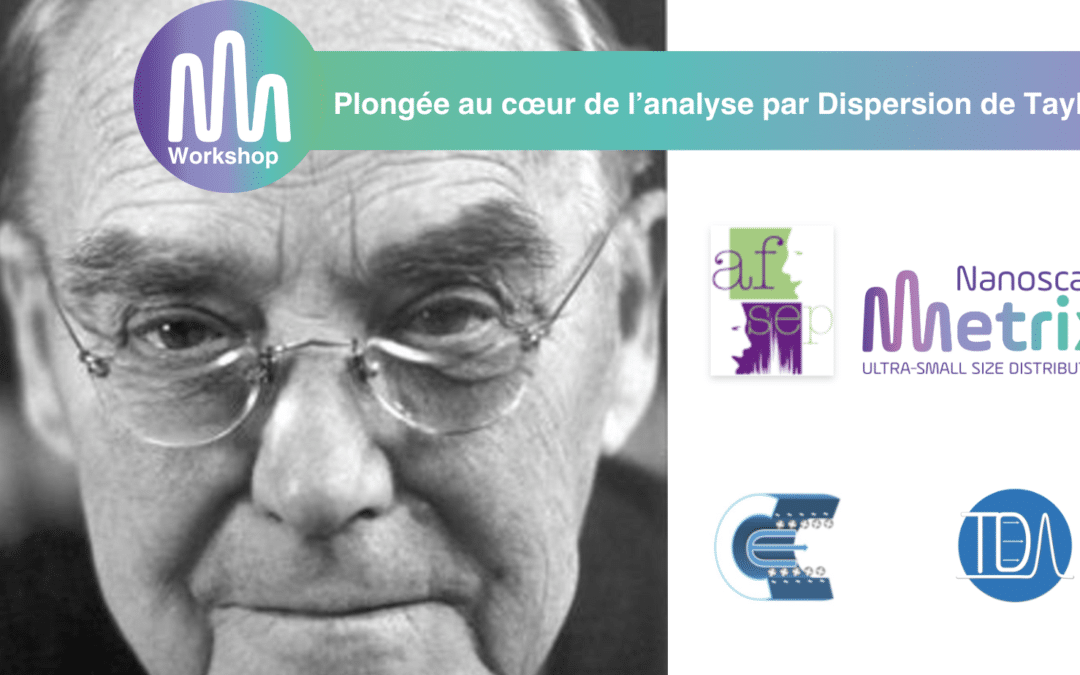Le groupe CE de l’Association Francophone des sciences séparatives et la société Nanoscale Metrix vous invitent à participer à une journée Workshop autour de l’analyse par Dispersion de Taylor le 5 Juillet 2024 de 9h à 16h à Montpellier.
Voici les intervenants qui vous présenteront leurs dernières avancées sur la TDA sont des chercheurs européens et des industriels travaillant.
Hervé Cottet, IBMM, Université de Montpellier
Prof. Hervé Cottet is full professor at the Biomolecule Institute in Montpellier (IBMM). His research work concentrates at the interface between separation sciences, analytical chemistry, polymers and pharmaceutical sciences, with expertise in Capillary Electrophoresis (CE) and Taylor Dispersion Analysis (TDA). He is both interested in fundamentals and practical (or industrial) applications of CE and TDA. Recent advances include the development of TDA applications (mRNA loaded lipid nanoparticles, biomolecule aggregation, biomolecular interactions, vaccine antigens, MRI contrast agents…) and a better understanding of TDA principles and limitations (adsorption, coatings, limits in size, processing of the taylorgrams, limit of detection, new detection modes…). He has co-authored more than 150 scientific articles dealing with CE and/or TDA.
https://ibmm.umontpellier.fr/dsbc/hcottet/index.html
https://orcid.org/0000-0002-6876-175X
Patricia Taladriz & Sandor Balog – Adolphe Merkle Institute, University of Fribourg, Fribourg, Switzerland
Dr. Patricia Taladriz-Blanco obtained her bachelor’s degree (2007) and PhD in chemistry (2012) from the University of Vigo, Spain. Dr. Taladriz is an interdisciplinary researcher working in the field of nanoparticle detection in complex environments, with a particular emphasis on nanoplastics. Her other research interests include thermoplasmonics, microfluidics (microdroplets), and bio-nano interactions. Currently, Dr. Taladriz works as a group leader at the Adolphe Merkle Institute (BioNanomaterials group, Fribourg, Switzerland), and her primary research line focuses on the detection of micro- and nanoplastic particles using well-established nanotechniques such as Raman, DLS, NTA, and TDA, among others.
Sandor Balog obtained a PhD in physics from the University of Fribourg (Switzerland) in 2007 based on experimental studies quantifying universal coherent wave-correlations in multiple light scattering. Before joining the Adolphe Merkle Institute at the University of Fribourg in 2012 as a staff scientist, he worked for the Paul Scherrer Institute (neutron scattering), Lausanne’s Federal Institute of Technology EPFL, (optical microscopy and spectroscopy on photonic crystal cavities) and CERN (optical methods for the Higgs boson and muons). Since 2012, Sandor’s activity has revolved around the theory, practice, and application of scattering, spectroscopy, and microscopy techniques in soft matter research. Taylor dispersion analysis has become a particular interest in the physical characterization of nanoparticles. Sandor’s forte is modelin, simulation, and data analysis, benefitting from applied mathematics and, recently, machine learning techniques
Philip Chennell, Pharmacie Hospitalière – Hôpital de Clermont-Ferrand
Philip Chennell is a Pharmacist, Assistant Professor and Hospital Practitioner. He obtained his master’s degree in 2012, his PharmD in 2013, and his PhD in 2018. He assumed teaching duties in 2014 at the University d’Auvergne (which became Clermont Auvergne University), and is now member of the research team UMR CNRS 6296 “Materials for Health” at the Institut de Chimie de Clermont Ferrand (ICCF). He is also in charge of the Control and Development laboratory unit of the pharmacy department of Clermont-Ferrand’s University Hospital. His current professional interests focus on pharmaceutical preparations (developpement and stability), medical devices and content-container interactions, including how drugs interact with infusion lines, tubings and catheters.
Sameh Obeid, Institut Galien, Université Paris Saclay
Sameh OBEID obtained his PhD in Nanobiotechnology from the University of Bourgogne-Franche-Comté in 2017. After his PhD, he held three post-doctoral positions at different institutes where he worked at the interface between biophysics and cell biology. In 2023, he joined the Institut Galien Paris-Saclay (CNRS), at the University of Paris-Saclay, as an associate professor of Biotechnology and Bioanalysis. His current research activities focus on the development of new microfluidic and microscale approaches for the isolation, detection and characterization of Extracellular Vesicles (EVs). He is particularly interested in exploring how the physicochemical properties of the EVs surface impact their functionalities regarding their application as biotherapeutics and nanovectors of therapeutic agents.
Alexander K. Buell, Technical University of Denmark
Alexander K. Buell was born in Stuttgart, germany. He studied general and physical chemistry at the University of Tübingen and at Ecole Normale Supérieure, Paris. He obtained a PhD in Biophysics in the Nanoscience Centre at the University of Cambridge, UK under the supervision of Prof. Sir Mark Welland and Prof. Sir Christopher Dobson in 2011. He then held independent research fellowships while working in the Chemistry department of the University of Cambridge in the group of Prof. Tuomas Knowles. In 2015, he moved to the University of Düsseldorf in Germany and took up an assistant professorship. In 2019, Alexander accepted a position as Full Professor of Protein Biophysics at the Technical University of Denmark, DTU. Alexander is the recipient of the 2023 EliteForsk prize of the Danish Ministry of Research and Education and in 2023 he also obtained an ERC consolidator grant.
Joseph Chamieh, IBMM, Université de Montpellier
Joseph Chamieh (MC HC, 37 publications) earned his PhD in analytical chemistry back in 2009 from the University of Strasbourg in France, under the supervision of Dr. Agnès Hagège. His doctoral research centered on advancing silica monoliths for liquid chromatography. Following his PhD, he embarked on a two-year postdoctoral contract in Lyon, collaborating with Professor Claire Demesmay’s team. Here, he focused on the development of an immunoconcentration microsystem employing an organic monolith as a chromatographic support. In 2011, He made his way to Montpellier for a one-year postdoctoral stay in the group led by Professor Hervé Cottet. During this tenure, his work revolved around applying Taylor Dispersion Analysis to monitor the degradation of dendrigraft poly-L-Lysine. Subsequently, he was appointed as an Associate Professor in Professor Cottet’s group, where his research concentrates on the application of Taylor dispersion analysis and electrophoretic methods to investigate weak biomolecular interactions.
Yasmine Sebti, Nanoscale Metrix
Yasmine Sebti is an applications engineer at the Nanoscale Laboratory. She contributes to helping the science of UltraSmall NanoObjects follow in the footsteps of the pioneers of Taylor dispersion!
She works on particle size distribution of very small nanoparticles or molecules using cutting-edge Taylor dispersion technology at the crossroads of the worlds of research and industry.
Michel Martin, ESPCI ParisTech, Paris
I am an emeritus Research Director at CNRS (French National Centre for Scientific Research). My research activities focus on fundamental physicochemical and hydrodynamic phenomena involved in separation of mixtures of small molecules, macromolecules or particles by various methods (chromatography, field-flow fractionation, capillary electrophoresis, Taylor dispersion analysis). Since the last thirthy-five years, they were conducted in the Laboratoire de Physique et Mécanique des Milieux Hétérogènes at ESPCI – Paris.
Agnès Hagège, Institut des Sciences Analytiques, Université de Lyon
Agnès Hagège is a researcher of the French National Center of Scientific Research (CNRS).She holds a PhD degree in analytical chemistry from the University of Lyon.
Her research activity focuses on metal/ biological compound interactions and metal-based compounds in biological fluids by means of separation sciences: capillary electrophoresis, affinity capillary electrophoresis, HPLC, IMAC.
She develops particularly the use of capillary electrophoresis and its hyphenation with ICP/MS for monitoring the distribution of metals in biological samples and determining affinity constants.
Nadia Delon-Anik, Syensqo, Saint Fons
Nadia DELON-ANIK is an expert in polymer and materials characterization at the Syensqo St Fons (formerly Solvay) Research and Innovation Center.
She holds a PhD in analytical chemistry from the University of Montpellier, under the supervision of Prof. Hervé Cottet. Her thesis work contributed to the development of the capillary electrophoresis technique for characterizing synthetic polymer architectures. Her current research focuses on developing innovative analytical methods for characterizing the multi-scale structure of polymers and materials, and understanding their structure-property relationships.
Chutintorn Somnin, Université de Montpellier in collaboration with Guerbet
Chutintorn SOMNIN received her Master’s degree in Analytical Chemistry from Mahidol University (Bangkok, Thailand) in 2021. She is now a PhD student at the University of Montpellier under the supervision of Prof. Hervé Cottet and Dr. Joseph Chamieh. Her thesis topic deals with the comparison of different detection modes for the sizing of nano-objects and the study of their interactions with biopolymers using Taylor dispersion analysis and Capillary Electrophoresis.

